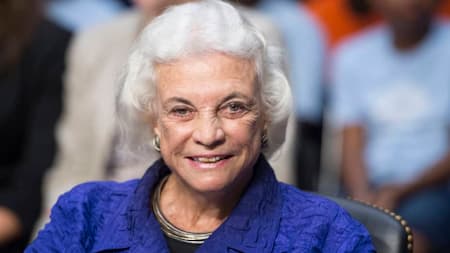Sandra Day O’Connor Biography Information

Sandra Day O’Connor, an American lawyer, politician, and jurist, served as an associate justice of the Supreme Court of the United States from 1981 to 2006. She made history as the first woman to hold the position.
Characterized as a moderate conservative, O’Connor was renowned for her meticulously researched opinions. Nominated by President Ronald Reagan, she played the role of a swing vote during the Rehnquist Court and the initial months of the Roberts Court.
Before joining the Supreme Court, O’Connor had a notable career as a judge and elected official in Arizona. She served as the first female majority leader of a state senate, holding the position of Republican leader in the Arizona Senate.
Her nomination to the Supreme Court received unanimous confirmation from the Senate. Announcing her retirement on July 1, 2005, O’Connor expressed her intention to step down upon the confirmation of her successor. Samuel Alito was nominated to fill her seat in October 2005 and officially joined the Court on January 31, 2006.
O’Connor, often aligning with the Court’s conservative bloc, demonstrated flexibility by occasionally siding with its liberal members. Notable contributions include majority opinions in landmark cases such as Grutter v. Bollinger and Hamdi v. Rumsfeld.
She played a role in the per curiam majority opinion in Bush v. Gore and co-authored the lead opinion in Planned Parenthood v. Casey. Throughout her tenure, O’Connor was recognized in various publications as one of the most powerful women globally.
Following her retirement, O’Connor succeeded Henry Kissinger as the Chancellor of the College of William & Mary. In 2009, she was honored with the Presidential Medal of Freedom by President Barack Obama.
Born in El Paso, Texas, to rancher Harry Alfred Day and Ada Mae (Wilkey), Sandra Day grew up on a vast family cattle ranch near Duncan, Arizona. Her upbringing lacked modern amenities, with the family home gaining electricity and running water only when she was seven.
Despite the challenges, O’Connor’s resilience and experiences on the ranch shaped her character. She had two younger siblings, Ann Day and H. Alan Day, with whom she later co-authored the book “Lazy B: Growing up on a Cattle Ranch in the American West” (2002).
Sandra Day O’Connor Education Background
Sandra’s early education took place in El Paso, but she spent her eighth-grade year at the ranch, commuting 32 miles by bus to school. She graduated sixth in her class from Austin High School in El Paso in 1946.
At the age of 16, Sandra Day enrolled at Stanford University, where she achieved magna cum laude honors upon earning her B.A. in economics in 1950. Continuing her education, she pursued a law degree at Stanford Law School, completing it in 1952.
During her time at the law school, she collaborated with future Supreme Court Chief Justice William Rehnquist as they both served on the Stanford Law Review. Day and Rehnquist were romantically involved in 1950, but their relationship concluded before Rehnquist graduated early and relocated to Washington, D.C.
Despite the separation, Rehnquist proposed to Day in 1951 through a letter, an offer she declined. This was one of four marriage proposals she received during her time at Stanford. Notably, Day attained the Order of the Coif, signifying her placement in the top 10 percent of her class.
Sandra Day O’Connor Supreme Court
On July 7, 1981, President Reagan, who had promised during his 1980 presidential campaign to appoint the first woman to the Supreme Court, declared his intention to nominate Sandra Day O’Connor as an associate justice.
This nomination was to fill the vacancy left by the retiring Potter Stewart. O’Connor learned of her nomination from President Reagan the day before the official announcement and was unaware that she was a finalist for the position.
Feeling a sense of responsibility to demonstrate that women could effectively serve as justices, O’Connor faced practical challenges, including the absence of a women’s restroom near the Courtroom.
President Reagan formally presented O’Connor’s nomination on August 19, 1981. Two years into O’Connor’s tenure on the Court, The New York Times published an editorial that referred to the “nine men” of the “SCOTUS” (Supreme Court of the United States).
In response, O’Connor wrote a letter to the editor, pointing out that the Court was no longer exclusively composed of men and humorously labeling herself as FWOTSC (First Woman On The Supreme Court). Known for promoting camaraderie among justices, O’Connor often advocated for shared lunches among the members of the Court.
In 1993, Ruth Bader Ginsburg became the second female Supreme Court justice, a development that brought relief to O’Connor, who no longer bore the sole burden of being the only woman on the Court. In May 2010, O’Connor cautioned female Supreme Court nominee Elena Kagan about the challenging and “unpleasant” nature of the confirmation hearings process.
Sandra Day O’Connor Retirement
On December 12, 2000, The Wall Street Journal reported that Sandra Day O’Connor was hesitant to retire during a Democratic presidency. During an Election Night gathering at the home of Mary Ann Stoessel, widow of former Ambassador Walter Stoessel, O’Connor’s husband, John O’Connor, expressed her desire to step down to those present. He mentioned that she would be reluctant to retire if a Democrat occupied the White House, as that president would choose her successor. Although Justice O’Connor declined to comment, this information was relayed by three witnesses.
By 2005, the Supreme Court’s composition had remained unchanged for eleven years, marking the second-longest period in American history without any alterations. Speculation surrounded potential retirements, with Chief Justice William Rehnquist and Justice O’Connor being primary subjects. On July 1, 2005, O’Connor announced her intention to retire, stating in her letter to President George W. Bush that her retirement would be effective upon the confirmation of her successor. While the letter did not provide a specific reason for her departure, a Supreme Court spokeswoman confirmed that O’Connor was leaving to spend more time with her husband.
President Bush nominated D.C. Circuit Judge John Roberts on July 19, 2005, to succeed O’Connor. Despite considering Roberts an excellent and highly qualified choice, O’Connor expressed disappointment that her replacement was not a woman. Originally planning to leave the Court before the start of the next term in October 2005, Rehnquist’s death on September 3 created an immediate vacancy. Consequently, Bush withdrew Roberts’ nomination for O’Connor’s seat, appointing him instead to the position of Chief Justice. O’Connor agreed to stay on the Court until her replacement was named and confirmed, even speaking at Chief Justice Rehnquist’s funeral.
President Bush nominated White House Counsel Harriet Miers on October 3, 2005, to replace O’Connor. After facing criticism and controversy, Miers withdrew her nomination on October 27, prompting Bush to resume the search for O’Connor’s successor. The prolonged delays in confirming a replacement extended O’Connor’s tenure on the Court, during which she continued to hear cases, including those involving contentious issues like physician-assisted suicide and abortion. O’Connor’s final opinion, Ayotte v. Planned Parenthood of New England, written for a unanimous court, dealt with a procedural matter related to a challenge against a New Hampshire abortion law.
On October 31, 2005, President Bush nominated Third Circuit Judge Samuel Alito to replace O’Connor. Alito was confirmed by a 58–42 vote and was sworn in on January 31, 2006. Following her retirement, O’Connor continued to hear cases and issued over a dozen opinions in federal appellate courts, serving as a substitute judge when needed. Reflecting on Alito’s nomination, O’Connor remarked, “I’ve often said, it’s wonderful to be the first to do something, but I didn’t want to be the last.” She expressed concern that her retirement was not followed by the appointment of another woman to the Supreme Court, leading her to ponder whether she had somehow contributed to this outcome.
Sandra Day O’Connor Age
Day was born in El Paso, Texas, on March 26, 1930. She died on December 1, 2023, at the age of 93.
Sandra Day O’Connor Death
In approximately 2013, associates and friends observed a decline in Sandra Day O’Connor’s memory and conversational abilities. By 2017, back issues necessitated her use of a wheelchair, leading to her transition to an assisted living facility.
In October 2018, O’Connor publicly disclosed a diagnosis of early-stage dementia resembling Alzheimer’s disease, prompting her effective retirement from public life. On December 1, 2023, O’Connor passed away in Phoenix, succumbing to complications arising from advanced dementia and a respiratory illness. She was 93 years old.
Sandra Day O’Connor Husband | Sandra Day O’Connor Family
While in her last year at Stanford Law School, Sandra Day began a relationship with John Jay O’Connor III, who was one year junior to her. Six months after graduating, on December 20, 1952, O’Connor and Day tied the knot at her family’s ranch. Despite earning her law degree, O’Connor faced challenges securing a paying job in a law firm due to gender-related biases.
Undeterred, O’Connor accepted a position as a deputy county attorney in San Mateo, California, where she volunteered to work without a salary or office, sharing space with a secretary. After a few months, she started receiving a modest salary while conducting legal research and preparing memos. Collaborating with San Mateo County district attorney Louis Dematteis and deputy district attorney Keith Sorensen, O’Connor began her legal career.
When her husband was drafted, O’Connor decided to accompany him to Germany, where she worked as a civilian attorney for the Army’s Quartermaster Corps. They spent three years in Germany before returning to the United States, settling in Maricopa County, Arizona, to start their family. The O’Connors had three sons: Scott (born in 1958), Brian (born in 1960), and Jay (born in 1962). Following the birth of Brian, O’Connor took a five-year hiatus from practicing law.
Sandra Day O’Connor Salary
Sandra used to make $700319 per year.
Sandra Day O’Connor Net Worth
O’Connor had an estimated net worth of $8 million which she has accumulated throughout her career.
Sandra Day O’Connor Body Measurements
| Height | 5 feet 5 inches |
| Weight | approximately 60 kg |
| Eye Color | green |
| Hair Color | white |



